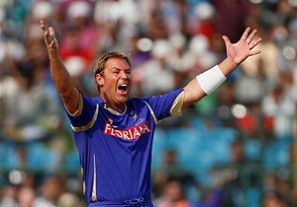Virat Kohli absolutely filthy after his wicket was upheld on controversial waist-high delivery
The Third Umpire ruled that he was standing outside his crease and the ball was dipping, making it a fair delivery - but the…

The first season of the Indian Premier League opened in a blaze of glory. The competition promised to re-define cricket.
Teams were known as franchises, players were purchased in auctions – fetching prices that Sir Donald Bradman could only have imagined – while dancers, fireworks and superstar franchise owners pledged to deliver a pure entertainment package.
For a time, the competition delivered.
Commentators appeared apoplectic when describing the cricket on display, which was suddenly far more entertaining than boring-old international fixtures.
This was the dawning of a new era of ‘DLF Maximums’ (the IPL term for a cricket shot which clears the boundary, reaping six runs for the batsman), gaudy cricket uniforms and cricket mercenaries.
However, something has since gone wrong. The previously recession-proof IPL is suffering from a downturn in interest from the cricketing and, perhaps more importantly, the non-cricketing public as well.
Viewer numbers are well down for the fifth season of the IPL.
Figures released by TAM Sports, a division of Indian company TAM Media Research, show that television rating points (figures which account for number of viewers and time spent watching a program) for the first six matches of the 2012 tournament were 3.76, as opposed to the 4.63 average in 2011.
This represents a significant drop from the third IPL season in 2010, where an average of 5.72 was enjoyed.
Writing for Cricinfo, Tariq Engineer reported that this decline could be attributed to “cricket fatigue and a lack of familiarity with the teams”.
While television audiences are down, sponsors have also been lukewarm in their response to IPL five.
Previous sponsors, LG and Godrej, opted out of the 2012 installment of the IPL, while Canon reduced their spending on advertisements considerably. They only shelled out 20 percent of their 2011 advertising budget for the IPL.
Speaking with Times of India recently Alok Bharadwaj, senior VP at Canon India, stated that “advertisers are starting to look at other options. Each year the rates have gone up by 15-20 percent and the returns are not directly proportionate.”
As mentioned by Vijay Tagore, reporting for DNA India, speculation is rising concerning the longevity of sponsorships from Hero Moto Corp, Citi, Volkswagen, Vodafone and Karbonn Mobile.
Furthermore, Tagore reports that title sponsor DLF is unlikely to renew a five year deal, which ends this year.
Kings XI Punjab COO Arvinder Singh told India Today that the recent poor performance of the Indian team has had a negative impact upon sponsors, stating that “the Indian team is the core of any sponsor”.
Furthermore, there is strong speculation that DLF, who have been the title sponsor since the inception of the event 2008, will not seek to renew their five-year contract when it expires this year.
Coupled with the loss of sponsors already mentioned, it would appear that the IPL is facing something of a crisis. Further compounding these problems is a 2011 report released by Brand Finance, which downgraded the value of the IPL from US$4.13 billion in 2010 to US$3.67 billion.
Chief growth officer at Lodestar Universal Habeeb Nizamudin argues that poor brand building is to blame for the downturn, with the IPL board and teams culpable.
“No initiative has been taken to build brand loyalty, which is a revenue growth enabler for franchises.”
Furthermore, the changeability of the team structures has been blamed for the limited affection shown by fans towards their teams.
The signs are not good for the IPL. The sheer size of the Indian cricket market should ensure that the IPL is able to persist.
Should the Indian cricket team decide to start playing some decent cricket, then the peripheral supporters may return. However, the tournament is not as robust as proponents would argue.